After testing lightweight 100- to 129-grain-bullet 38 Special loads in the July 2021 issue, we turned to testing heavy-bullet loads in 38 Special. We were able to find a good mix of loads, including four lead hollow-point choices. At 38 Special velocity, heavy-bullet loads using jacketed bullets are not likely to expand, so we tested a single jacketed hollow point in 158-grain weight confirm our experiences. In contrast, lead bullets may be soft enough for expansion at velocities lower than 1000 fps, so we checked out several of those as well.
Several notes on lead hollow points. They expand reliably, penetrate well, and function reliably. They are not as accurate as the usual jacketed bullet. Semi-wadcutter and wadcutter bullets at modest velocity may be among the most accurate loadings. We would recommend against any non-expanding bullet in this weight range because penetration is excessive for personal defense, with the exception of the target wadcutter. If you need a load that is useful for protection against animals with heavy bones and the 38 Special is all you have, the Buffalo Bore Outdoorsman load is a good choice. We also tested the sometimes-recommended 148-grain wadcutter. This load has been used by older shooters for many years, and we found there is something to it. In times of shortage, it is good to know the performance of the ammunition in that box, whatever the brand. We found several good choices and others we cannot recommend in the 148- and 158-class 38 Special cartridges, and we detail their performances below.
Federal Premium Gold Medal Match 38 Special 148-grain Lead Wadcutter GM38A
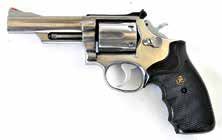
For many years, personal-defense experts have recommended the 38 Special wadcutter as a home-defense choice for those who cannot handle a heavier load, particularly in small-frame snubnose revolvers. For the occasional shooter, a heavy +P in a lightweight revolver is a big obstacle to proficiency. Accuracy isn’t a question with this load, and control is practically effortless. Velocity from a 4-inch barrel is 703 fps.
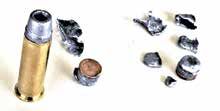
The premise of recommending this load over the 158-grain RNL loading was that it really isn’t that much slower, and the blunt cookie-cutter nose would cut rather than push flesh aside. In this regard, the bullet profile should be equal to the long-nose semi-wadcutter. Surprisingly, the Federal load penetrated 24 inches of water, less than the 158-grain RNL or SWC loads. The broad nose slows down the bullet. If you cannot control heavier 38 Special loads, this is a viable choice. We would rate it superior to the 32s and 380 ACP in most cases. We rated it down a full grade on a lack of expansion and another grade based on too-deep penetration.
Gun Tests Grade: C
Buffalo Bore 158-grain Heavy 38 Special +P Soft-Case Lead Semi-Wadcutter Hollow Point Gas Check 20A/20
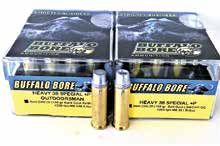
This load uses a cast rather than swaged lead bullet. The non-scientific thumbnail scratch test showed the lead is soft, but not as soft as the Winchester bullet, in comparison. The bullet is also gas checked to eliminate leading. The Buffalo Bore loading breaks an impressive 1003 fps from a 4-inch-barrel Smith & Wesson Model 66. Penetration was on the long side at 24 inches. Those facing heavily bundled attackers in winter will appreciate this load. This is among the few lead bullets we have tested that fragments. The nose blew off. Sometimes the nose was in one chunk, and other times it shattered into several pieces. When this bullet struck the water jugs, the jugs were flung about violently. This is an impressive load. In the K-frame revolver, recoil was modest compared to a Magnum, but it was heaviest of the test, save for the Outdoorsman load. In a 2-inch-barrel revolver, it would be more difficult to control. We rated it down a half grade based on its over penetration. Just the same, this is the top load for terminal ballistics in a 4-inch-barrel revolver.
Gun Tests Grade: A-
Federal Train + Protect 158-grain Lead Semi-Wadcutter Hollow Point TP38VHP1
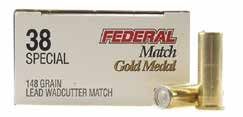
This is sold in 50-round boxes with a VHP “versatile hollow point” advertised. The load is intended to be useful for both training and defense use. Accuracy is in the normal standard-pressure range and was reliable. Velocity is 786 fps. Penetration is 24 inches of water. There was no expansion, with the recovered bullets averaged 0.36 inches in diameter. Penetration was less than a RNL load of similar velocity.
Interestingly, the Winchester non-hollow-point SWC penetrated greater than this load. The open nose of the Federal bullet apparently slows penetration. There are better loads for personal defense, but there are worse as well. We rated this loading down a full grade based on a lack of expansion. For those looking for a low-recoil load, this may be a better choice than the target wadcutter.
Gun Tests Grade: B
Hornady Custom 158-grain XTP JHP 90362
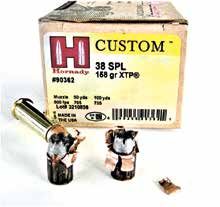
This is a very accurate loading. It is also easy to control. This is an advantage for some shooters. Velocity is 780 fps in the 4-inch-barrel Model 66. The bullet core itself did not expand at all, not a shock at this velocity. Surprisingly, the copper jacket expanded off to one side or the other during testing. We measured the jacket and found that it sometimes expanded to 0.42 inch in diameter. This isn’t a top defense load, but we would use it over a 158-grain RNL or a lead semi-wadcutter bullet.
Gun Test Grade: B-
Remington Express 158-grain Lead Semi-Wadcutter Hollow Point +P R38S12
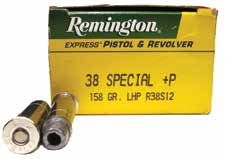
This load is very similar in appearance and performance to the Winchester loading. The Remington load breaks 869 fps and averages 18 inches of penetration. All recovered bullets measured 0.60 inch in diameter, the most consistent of the test. This is our recommended heavy-bullet loading in the test based on its consistent expansion and penetration.
Gun Tests Grade: A (Our Pick)
Winchester Super-X 158-grain Lead Semi-Wadcutter Hollow Point +P X38SPD
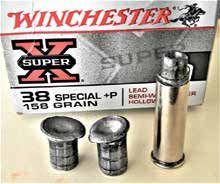
This is a lead hollow point molded or cast soft enough for reliable expansion. Average velocity is 861 fps from a 4-inch barrel. The Winchester load has probably seen more use than other lead hollow points because it was issued to peace officers decades ago. This appears to be the same load in use since the 1970s. Penetration is 20 inches in water. Expansion ranged from 0.51 to 0.54 inch. We recommend this Super-X load for personal defense.
Gun Tests Grade: A
Winchester Super-X +P Lead Hollow Point Semi-Wadcutter X38WCPSV
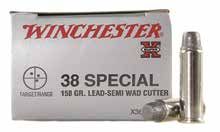
This is a non-hollow-point load. While it is a +P choice, its 799-fps velocity isn’t appreciably greater than a standard-pressure load. Penetration is more than 42 inches. We did not waste more water jugs trying to capture a bullet from this load when the first shot exited the seventh water jug. We rated the 158-grain SWC +P down a grade on a lack of expansion and another grade based on its over penetration.
Gun Tests Grade: C
We also tested a couple of non-expanding loads to get some reference on how they might compare to the standard 38 Special RNL loading. We came up with some surprising results. We did not rate the Black Hills Ammunition 158-grain Cowboy load because it is designed for economy and accuracy for match shooting, not personal defense. It simply isn’t fair to put a personal defense rating on it. Neither did we rate the Buffalo Bore 158-grain Outdoorsman, because it is designed for animal defense and outdoors hunting, not personal defense. Just the same, in certain situations it might be a great choice. Following are the results for these two choices just for information purposes.
Black Hills Ammunition 158-grain Cowboy Flat Point
This load is designed for light recoil and accuracy. Sure enough, it was the most accurate loading tested. At 699 fps, the load is controllable. This is as close as we could come to the standard 158-grain round nose load often referred to as the widow maker based on poor wound potential. Penetration is on the long side at 36 inches.
This isn’t the type of performance needed for personal defense.
Buffalo Bore 158-grain Outdoorsman Heavy 38 Special +P Hard-Cast Keith Style 20H/20
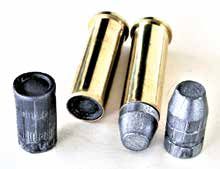
This heavy loading is intended to duplicate the original Keith-type loading that led to the 357 Magnum. Sometimes these choices were referred to as 38-44 loads and were intended for use in heavy-frame 38 Special revolvers. This is a true Keith-style semi-wadcutter with a long nose and well-defined cutting shoulder. Swaged lead bullets do not have this profile. It is hard cast, which means it will not lead the barrel much. With so much of the bullet forward, more powder may be used with less pressure. This is a heavy load, breaking 1120 fps, nearly as fast as many 158-grain 357 Magnum loads. Pressure signs were normal in the few rounds fired in a 4-inch-barrel Military & Police revolver as a side test. Accuracy and ballistic testing was accomplished with the Smith & Wesson 357 Magnum. We stopped testing when the load penetrated 48 inches of water and exited. This is an outstanding load for animal defense, nearly as strong as a 357 Magnum, but also controllable and accurate.
The Bottom Line
To briefly recap our previous test of lighter 38 Special loads in the July 2021 issue, we said the new Federal Punch ammunition is a good choice, if you can get it. The Black Hills Ammunition HoneyBadger is a good example of cutting-edge all-copper bullet technology, and the Fiocchi load with that bullet makes an excellent showing. Based on terminal ballistics, Buffalo Bore’s low-flash 38 Special defense load was at the top of the heap.
In this round of testing heavy loads, we immediately eliminated half from the top of the list. The non-expanding loads simply are not ideal for defense use. While the 38 Special Outdoorsman is excellent for animal defense and the 148-grain wadcutter is a useful compromise, neither possess the ideal qualities for a personal-defense load. This left us with the lead hollow-point loads. The Federal Train + Protect load failed to expand. It is a useful low recoil load and comes in number four on our list.
There is little practical difference between the Winchester and Remington loads. We would use either with confidence. Control is good even in snubnose 38 Special revolvers. In a 357 Magnum or midsize 38 Special, the Buffalo Bore LSWCHP load is the most formidable 38 Special loading tested of any type, including the jacketed hollow-point loads previously tested. These loads make the tired old 38 Special a viable personal and home-defense ammunition choice.
38 Special Performance Data
| Bullet Weight (Grains) | Manufacturer, Brand, and Product Number | Average Velocity (fps) | Standard Deviation (fps) | Muzzle Energy (foot-pounds) | IPSC Power Factor | Average Accuracy (inches) | Expanded Width (inches) | Retained Weight (grains) | Retained Weight (percentage) | Penetration In Water (inches) | Gun Tests Grade |
|---|---|---|---|---|---|---|---|---|---|---|---|
| 148 | Federal Premium Gold Medal Match LWC GM38A | 703 | 11 | 162 | 104 | 1.25 | 0.36 | 148 | 100% | 24 | C |
| 158 | Buffalo Bore LSWHP-GC 20A/20 | 1003 | 19 | 353 | 158 | 1.45 | FRAG | 101 | 64% | 24 | A- |
| 158 | Federal Train + Protect LSWHP TP38VHP1 | 786 | 22 | 217 | 124 | 1.9 | 0.36 | 158 | 100% | 24 | B |
| 158 | Hornady Custom XTP JHP 90362 | 780 | 5 | 213 | 123 | 1 | 0.4 | 158 | 100% | 24 | B- |
| 158 | Remington Express LSWHP +P R38S12 | 869 | 25 | 265 | 137 | 2.5 | 0.6 | 158 | 100% | 18 | A |
| 158 | Winchester Super-X +P LHPSW X38SPD | 861 | 17 | 260 | 136 | 1.5 | 0.52 | 158 | 100% | 20 | A |
| 158 | Winchester Super-X +P LSW X38WCPSV | 799 | 39 | 224 | 126 | 1.6 | 0.36 | 158 | 100% | 42+ | C |
| 158 | Black Hills Cowboy DCB38N1 | 699 | 29 | 171 | 110 | 0.9 | 0.36 | 158 | 100% | 36 | * |
| 158 | Buffalo Bore Outdoorsman 20H/20 | 1122 | 12 | 442 | 117 | 1.2 | 0.36 | 100% | 48 | * |
Notes: Average Velocity and Standard Deviation readings were obtained by firing 20 rounds over a Competition Electronics Pro Chrono. Ambient temperature: 90 degrees. Elevation: 815 feet above sea level. The accuracy figures are the average of three five-shot groups. For accuracy, we fired the test gun from a benchrest at a 25-yard target. l T calculate IPSC power factor, multiply bullet weight in grains by the velocity in fps, then divide by 1000. *Not graded, specialty bullet type.


























Greetings,
After years of carrying a large semi auto in .45 and .40 as a duty gun, I find I am gravitating to the mid size .38’s in my “golden years.” Your article on .38 loads is most welcome.
I am trying to determine if I am miscalculating, which is quite possible with my aging brain. Should the IPSC power factor for the 158 grain Buffalo Bore Outdoorsman be 177, rather than the 117 listed in the chart?
I carry that round in a 3″ Taurus 856 as a back country/predator round. I shoot the round in question infrequently in practice, as it is a bit stout, and at times hard to come by. But I do have confidence in it for that application. Is my belief misplaced?
As a side note, I find the Taurus 856 to be a good house/carry gun. At $359.00, it is a gun that doesn’t cause fretting if “cosmetic mishaps ” occur. The Taurus seems to handle the Buffalo Bore rounds without problem, fired infrequently. I usually load it with the Buffalo Bore 158-grain Heavy 38 Special +P Soft-Case Lead Semi-Wadcutter Hollow Point Gas for the house carry applications.
Thank you for your informative, and educational publication.
Back in the early 90’s I carried a S&W model 10 with a 4-inch tube. Nice gun, but when I fired a 158-grain LSWC at a piece of wood at 10 feet and had said bullet bounce back and put a welt on my leg, I gave up on it as a viable weapon. I now carry a snub-nosed .327 Federal Magnum revolver when using a wheel-gun, or a 10mm Auto when packing an auto.
Mr. Sigwarth wrote – “I am trying to determine if I am miscalculating, which is quite possible with my aging brain. Should the IPSC power factor for the 158 grain Buffalo Bore Outdoorsman be 177, rather than the 117 listed in the chart?”
Good catch by Mr. Sigwarth – I also calculate 177 (NOT 117.) Looks like a typo in the article.